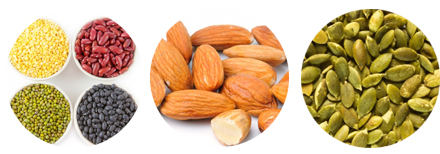
Proteins and carbohydrates seem to be slogging it out in the popular press, with carbohydrates getting the tougher end of the deal. Proteins seem to have achieved a sort of mythical status. Here we find out the facts about proteins and how we should incorporate them in our diet.
Proteins are made of amino acids (which we need)
Proteins are molecules used by the body for structure and other functions such as defence. They are formed of smaller molecules call amino acids which each have their own role to play in the body. There are 22 types of amino acid which we use in the body. The body, being the clever thing it is, can manufacture most of these but there are 8 which it can’t make. We have to get these 8 essential amino acids through diet.
Proteins build us
As you can imagine, these proteins are essential to health. When we eat and digest proteins they are broken down into amino acids. These are used to provide structure in the body and for biochemical reactions (e.g. enzymes), defence (e.g. antibodies) and transport. The structural and functional elements in our body are constantly being broken down due to wear and tear and so need to be replaced daily.
Proteins are in both animal and plant products (but they aren’t made equal)
Most people equate meat with protein but you can get protein from both animal and plant products. The important thing to note here is that all proteins are not made equal.
There are 8 essential amino acids which the body absolutely needs to function properly. Protein sources which contain these are called complete proteins. Those which only contain some are called incomplete proteins. Luckily for vegetarians and vegans, these incomplete proteins can be combined together to give the full complement of essential amino acids.
It is important to either have some complete proteins or the correct mixture of incomplete proteins to maintain the best level of health.
Complete Proteins include all animal and a few plant proteins:
- all animal derived products e.g. fish, meat (red and white), eggs and dairy.

- a few plant products: soya (and its products such as tofu and soya milk), quinoa, millet, algae (e.g. spirulina) and avocado.
Incomplete Proteins include most plant proteins such as:
- legumes (beans and lentils, e.g. mung beans, red lentils, white beans, chickpeas, dried peas etc)
- grains (e.g. spelt, rice, barley, oats. Note that whole “brown” grains have about 25% more protein than refined “white” ones)
- nuts and seeds (e.g. pumpkin seeds, almonds, sunflower seeds)
- vegetables (generally low in protein, highest percentages in spinach, broccoli, sweetcorn, potato)
We need certain proteins every day
The body breaks down dietary proteins into amino acids and these form a pool of available amino acids for use around the body. The pool is small: it only lasts for about 48 hours. This means that we need to eat protein at least every 48 hours if not daily or else the body starts to break down the tissues and organs to get hold of the amino acids it needs.
Not only this, but we need to have all 8 essential amino acids during these 24-48 hours as without just one of them, the proteins we need can not be built. There are no replacements; the protein just doesn’t get built.
Therefore, ideally daily, but at least every 48 hours, we need to have complete protein foods or combinations in our diet.
This means we need to have one of the following every day:
- Animal derived protein (meat, fish, dairy, eggs)
- A complete vegetable protein (soya, quinoa, millet, algae or avocado)
- Specific combinations of incomplete proteins (not necessarily eaten at the same time, just in the same day).
Legumes and grains
Legumes and nuts or seeds
For example, for someone who doesn’t eat any animal derived products such as a vegan, they could get all the essential amino acids in a meal of brown rice and lentils.
We don’t need huge steaks, about 50g is enough
Modern guidelines state that each day we need about 0.7g per kg. That means, the average man of 80kg needs about 55g of protein a day. The average woman at 65kg needs about 45g of protein a day.
We need to have this amount of protein to maintain our bodily structures and functions. However, much more is not necessarily better. Excessive intake can be dangerous to health as it puts a great strain on the kidneys.
People tend to worry that if they don’t eat meat, they won’t get enough protein. It is true that you need to think a little more but luckily many native dishes naturally combine proteins in such as way that you get the right types in the right quantity. For example, in just two meals you could get the required amount of protein; porridge for breakfast with some nuts and seeds and some rice and lentils for dinner. If you eat meat, you could get your daily amount from just one small chicken breast.
Being mindful of how much meat we eat
Meat is not vilified in Ayurveda. There are some occasions on which meat is recommended, mainly when someone is frail and weak. However, meat is known to be difficult to digest, especially red meat. Thus, we need to be careful how much meat we eat.
In the UK, we have always had a meat-loving culture. This makes sense when you look at the weather and our history. With many people braving cold weather spending long days labouring, meat would have been an essential ingredient in our diets. It is indigenous and sustaining through high levels of exertion.
However, most of us are now not labouring all day in the elements and yet continue to eat meat as if we are. This is exacerbated by the fact that meat, which used to be quite a luxury, has become cheaper and more available. We need to re-evaluate the quantity of meat we eat. Most of us have a high ratio of meat to plant derived protein, putting a great strain on our digestion.
Ayurveda says our protein needs differ
The one-size-fits-all dietary guidelines have their limitations. In Ayurveda, the amount and type of protein you need varies with your constitution. The below guidelines include references to meat and fish but these are only if desired, you can live completely healthily without them.
If you don’t know which dosha you are predominant in, please have a look at the descriptions here.
Vata [tendency to be lighter, less grounded]
More protein in general, although made from small quantities in more frequent meals. Derived from:
- Milk products
- Eggs
- Grains (more white than wholegrain)
- Nuts and seeds
- Certain legumes. Cooked with spices and oils to calm the vata aggravating nature. The best legumes for vata are mung, tur dal and urad dal. In moderation, red lentils and soya.
- Some meat. Goat is easiest to digest and nourishing. Meat should be well-cooked, ideally in soups or stews.
- Some fish
As you can see from this, vata predominant people need to be very careful if following a vegan diet as it often doesn’t have the heaviness and moistness which they need. Good effort will need to be made to find these qualities in the vegan repertoire.
Pitta [tendency to have more heat and stronger digestions]
A medium level of protein, derived from:
- Milk products
- Most legumes
- Grains (a good mix of white and wholegrain)
- Almonds
- Seeds
- Meat in moderation, only if digestion is strong and demanding. White meats or venison only,
- A little fish, ideally oily
Kapha [tendency to heaviness]
A lower level of protein mainly derived from plant proteins:
- Most legumes
- Grains (mainly whole grains)
- Eggs
- Seeds in moderation
- Goats milk products in moderation
- A little fresh water fish
- Very little meat. White meat or venison only but generally best avoided.
Kapha individuals are the most suited to a vegan diet as it tends to be light and dry, the qualities which reduce kapha.
Red meats are the most difficult to digest. Pork and lamb are not recommended as they upset all three doshas. Beef is also difficult but can be eaten in small quantities by vata predominant people.
To cut down the meat we eat, we often need to learn more about cooking with legumes (pulses). The next blog post will be more information on pulses and some tips on how to cook them. For now, there are quite a few recipes in the recipe section here.
Until next time, take care of yourselves.
Kate
Author: Kate Siraj, Ayurvedic Practitioner, BSc Ayurveda, MChem (Oxon), MAPA.
© The Ayurveda Practice
Photos thanks to FreeDigitalPhotos.net







6 Comments
Susannah · April 10, 2024 at 00:50
I am pitta dosha who is also a non-secretor of blood type antigen into the tissues. This is a genetic variation in about 20% of the population at large. This means that I cannot break down nuts/seeds/beans/whole grains in my gut (no bifida bacteria). The phosphorus in the whole grains/beans/nuts will combine and pull out the calcium, magnesium, etc. in my body, and therefore many cavities can and have occurred in the past before I understood this condition. Therefore, I cannot eat these items in order to obtain my protein grams. I have to eat chicken breast or lake fish (I don’t do well with dairy either) to get the majority of my protein. Kind of depressing, as I really like oats and chickpeas. Any ideas out there?
Kate · April 10, 2024 at 10:45
Dear Susannah, sounds like proteins are a tricky area for you! I wouldn’t be so quick to assume that you can’t digest all grains and legumes, do double check that all that is substantiated by research. If you make sure you cook legumes, and also wholegrains, with spices and oils, that will help greatly with their digestion. If you are certain you can’t take them in any form due to substantial feedback from your body, then sticking to chicken and fish will work for you as long as you combine with plenty of green vegetables and avoid any other heating elements (chillis, tomatoes, alcohol etc) that could increase your pitta. Good luck!Kate
Pantry essentials - The Ayurveda Practice · January 29, 2016 at 08:36
[…] strong enough for brown rice. BUY FROM: any supermarket. CAUTION: make sure you have plenty of protein and vegetables with your rice or […]
Enjoy your Christmas roast with impunity this winter - The Ayurveda Practice · December 14, 2016 at 10:24
[…] Protein is heavy and grounding, along with generally having a sweet taste. Winter is the season where we can digest and indeed we need more protein. […]
Banish sugar cravings - The Ayurveda Practice · March 17, 2017 at 14:04
[…] high GI food (including juices and smoothies), often eating carbohydrates without some form of protein or overuse of […]
You’re not what you eat, you’re what you digest - The Ayurveda Practice · June 22, 2018 at 15:15
[…] a general rule, heavy foods are denser and contain more protein. Cold, dry, hard, raw or unspiced foods tend to be heavy. These foods have more earth element. […]